

|
The photographs compiled by Tara Jauhar in the new book The Mother: Selected Photos offer readers a silent immersion in the Mother’s consciousness and love. There are early photos from her life in Paris and haunting images from Japan, showing the Mother in the graceful kimonos which she wore when living there. There are portraits of the Mother taken in her room and scenes showing her at work, meeting people, even taking lunch with her attendants. She is at the Sportsground watching the events and in the Playground giving classes. She is shown playing tennis, in Paris and in the Ashram. One sees in the Terrace Darshan photos the loving compassion she showered on those who gathered below to receive her blessings. The Foreword of the book ends with these words:
This issue also features an article by Kirti Chandak on the book Tapasyā, a collection of spiritual paintings by Dhanavanti, which was introduced in the April eNews. | ||||||||||||||||||||||||||||||||||||||
|
| ||||||||||||||||||||||||||||||||||||||
ENGLISH | |
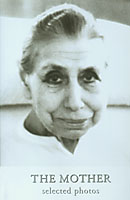 | The Mother: Selected Photos
— Compiled by Tara Jauhar |
More than 250 black-and-white photographs have been selected and arranged with a focus on one particular element: the powerful vibration that is radiated by the Mother’s physical appearance. Most are original pictures presented without touching up or repairing any defects; they are arranged without chronology or theme or identifying remarks so that the reader is left solely to experience the depth and dramatic power of the photographs. At the back of the book the pictures are reproduced in smaller size with dates and some brief comments. The book is printed on art paper. | |
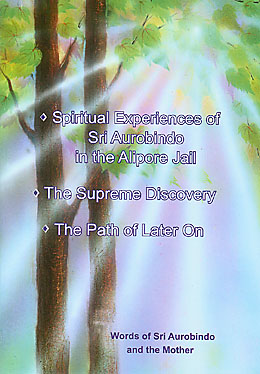 | Spiritual Experiences of Sri Aurobindo in the Alipore Jail The Supreme Discovery The Path of Later On — Words of Sri Aurobindo and the Mother |
| |
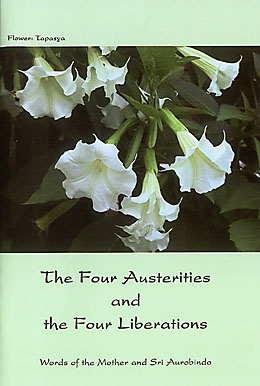 | The Four Austerities and the Four Liberations
— Words of the Mother and Sri Aurobindo |
| |
GERMAN/ENGLISH | |
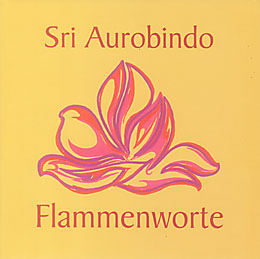 | Flammenworte (Englisch-Deutsch)
— Sri Aurobindo |
| |
TAMIL | |
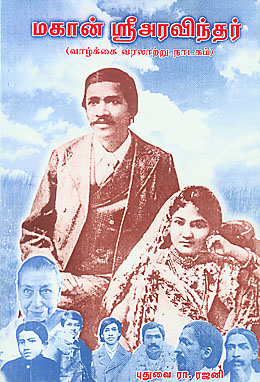 | Mahan Sri Aravindar
Vazhkai Varalatru Natagam |
| |
BENGALI | |
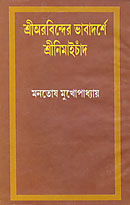 | Sri Aurobinder Bhavadarshe Shri Nimainchand
— Manotosh Mukhopadhyaya |
| |
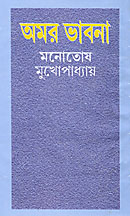 | Amar Bhavna
— Manotosh Mukhopadhyaya |
| |
GUJARATI | |
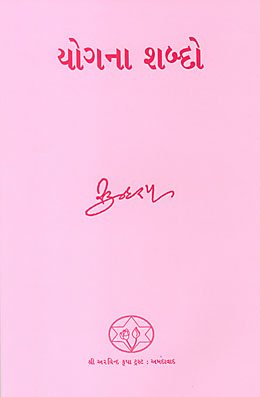 | Yogana Shabdo
— Sundaram |
| |
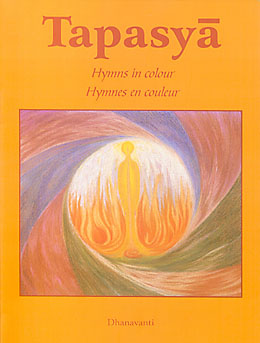
|
Tapasyā
Hymns in colour |
|
The paintings and drawings presented in this book depict the artist’s visions of inner worlds and experiences and express her own spiritual journey. The book is enhanced by the addition of eleven poems written by the artist and numerous quotations from the poems of Sri Aurobindo and Frank Townshend. There is also a short piece written by her which describes the genesis of her life as an artist. The text appears in both English and French. | ||
|
An article on the book by Kirti Chandak: The book Tapasyā: Hymns in Colour is retrospective in nature, covering the salient paintings done by Dhanavanti, a senior artist and member of the Sri Aurobindo Ashram. The book consists of thirty-one paintings, nine drawings and eleven poems written by her, along with quotations from Sri Aurobindo and Frank Townshend which have been added to the compilation and do not intrinsically form part of the inspiration for the creation of her works. The text is in English and French. The works printed here were done mainly from the 1960s to the late 1970s in pastels except for two works in watercolours. Dhanavanti learnt painting from Jayantilal Parekh for about two years and was constantly guided and encouraged by the Mother. When the Ashram school started, the children painted in a small room. Once an exhibition was organised there and the Mother came to see it. She asked Dhanavanti (a student then), ‘Is this where you paint?’ When Dhanavanti replied in the affirmative, the Mother told her that a studio had to be big and open to the north with a lot of light coming in. She called Udar Pinto and Jayantilal Parekh then and there and said, ‘Udar, you must give them a studio.’ Thus above the Flower Room the studio was later opened. On her birthday in 1967 the Mother gave Dhanavanti the key to her present domicile and said, ‘Içi tu vas faire beaucoup de peinture' (here you will do a lot of painting). In her new studio she worked intensely, often tearing up paintings because she was not satisfied, searching for what she wanted to express, shedding details, eliminating what was redundant, to arrive at a singular language that would express her inner journey. Once when visiting Brazil, she was giving a slide presentation of her paintings to some university students, when one of them interrupted her by saying, ‘You in the ashram live in a very secluded world; you don’t know what pain, poverty, hunger or unhappiness is, so you paint these flying figures.’ Dhanavanti told him, ‘If you know and experience these things in life, do you want me to give that again to you? That is precisely what I would not like to do, but give you just two drops of joy!’ After that there was a one-hour session of questions and answers along with the slide show. The teacher said at the end of the session that they had learnt something about oriental wisdom. The book can be looked at as an artist’s pilgrimage, in which the preoccupation is with the reality beyond the surface reality, where personal details are annihilated and the inner struggle is sublimated into a quest for the supreme. The whole journey is like a hymn in colour. There is a free-flowing energy from her works radiating peace, light and happiness, which is the result of her deep experiences and meditations. ‘Painting has been a means to help me discover myself. Nowadays I mainly like to doodle, letting my pen experience the essential Me’, says Dhanavanti. It is in this light that we can best fathom her works. | ||
|
The cover painting titled ‘Tapasyā’ was done when she was in a difficult situation. All the lines converge in a whirlpool, meeting at one point between the feet of the standing figure, trying to suck her in. But Dhanavanti uses this negative force to stand up, to rise above the flames of difficulty, determined to face the problem and overcome it through one-pointed determination. |
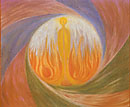 Tapasyā
TapasyāClick to enlarge | |
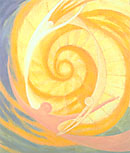 The Wheel of Life
The Wheel of LifeClick to enlarge |
In the painting ‘The Wheel of Life’ a gold-tinged celestial figure is seen plunging into the earth, a red-pink figure tainted by the mire is seen rising from the earth, and finally a transformed and enlightened being is seen returning to the source. A brilliant sun, origin of light and life, radiates life-energy whose rays become wavelike movements as the circle expands and completes the cycle of life. | |
|
The drawing on page 22, shown here to the right, could be seen as an autobiographical representation, suggestive of struggle and expressive in manner. Like the sudden awakening from an ignorant sleep, her bosom heavy with angst, she wants to break free from the earth, shaking off her heavy mantle to reach the beyond. In Dhanavanti's body of work there are other sketches that carry out this same theme. The figure identifies itself with the psyche of a tree—bound to the earth, yet dreaming of the skies. |
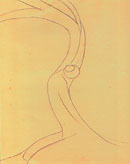
Click to enlarge | |
|
Dhanavanti’s paintings are ‘innerscapes’, expressions of the deeper self. Having trod the arduous path of thorns and fire, she reaches the luminous sun and dances in the joy of light. Her lines are curvilinear and free flowing. In her world of colours there is no darkness, only soft pastel shades emanating light and happiness. Figures search deep within, stretch to the beyond and flow on the waters of life to become one with the infinite. Life experiences are transformed into opportunities to unite with the One. Her works reveal a soul’s journey, to be seen with the inner eye and understood by the heart. | ||
You have received this as a subscriber to SABDA eNews. To unsubscribe, click here. To view previous issues of SABDA eNews, visit our Newsletters page.
|